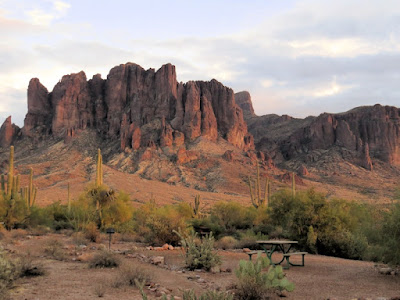What you see here is a sundial. It is a clock that tells time by the movement of the sun. These devices are the main reason that Arizona does not acknowledge Daylight Savings time changes. All these sundials would be inaccurate if they did. The sundial is great for us retired folks, if you can see the shadow, in this case from the Coyote on the left, then it is day and if you can’t see the coyote it is night. Pretty simple and really accurate.
We went down to the entrance station here at Lost Dutchman to get an Ice Cream. Yes the State Park sells Ice Cream. We were standing out front and noticed this unusual cactus. We stuck our head back inside and asked about it. No one seemed to know the name but finally one of the park employees came out and told us the story. It was an African Something-or-other. She did not know the exact name but it was a cactus from Africa. It seems when the building was constructed the landscapers were told to put in plants from the desert and so they did. There are plants from Africa, Australia, and various other world desert locations. They should have been told to use local or native desert plants that can be found in this area but were not. Hence we have an African Something-or-other.
There are a lot of Lesser Goldfinch here. Between them, Cactus Wrens, Abert’s Towhee, and other assorted critters attacking the niger sock we are having to fill it about every day and a half. A lot gets dropped on the ground and the Gambel’s Quail and mourning Doves are in feeding on the ground. There is a lot of activity.
In an earlier post we showed a Gilded Flicker with it’s wings outstretched. Here is a Gilded Flicker much closer for better inspection. It has a brown cap on its head and a white rump patch. You can see the gilding in lines on the folded wings.
It rained hard for an hour and a half one night. It was 3:00 AM when it started with lots of thunder and lightning. When we went for a walk the next day we saw several rocks with lime green lichen. The rain had brought out this color. It was quite a contrast to the drab browns and grays of the desert.
When I first saw these steps on the back of a camper I was hoping it was an escalator but such was not the case. I would have a lot of trouble navigating this entry and exit several times every day. It would be an accident just waiting to happen or one that just had.
The picnic table that you see in the foreground is “Hiker/Biker Campground Site #1”. It is not very far in from the road so you don’t have to hike or bike far to get here. The view is quite nice from your table sitting quietly having breakfast. Enjoy the view.
There are several Gnatcatcher species here in Arizona. This is a Black-tailed Gnatcatcher. They are very common, little gray birds that move around rather hurridly looking for insects to eat in the trees. The move their tail in a circular motion, have a white eye-ring and the underside of their tail is mostly black. The Blue-gray Gnatcatcher, another species here, has mostly white on the under tail.
The Gila Woodpekers and Flickers create nest cavities in the Saguaro. Many other species will uses thes cavities once the woodpeckers have finished with them. This appears to an interesting complex of homes and would be great to visit and watch in the spring breeding season.
There are a lot of Mourning Dove here. The park bird list also indicates Eurasian Collared Doves but we have not seen on here at the park as of yet. The dead tree type structure they are sitting on is a dead Cholla Cactus. The wood has become very hard with a fascinating structure.
A lot of species visit utilize the hummingbird feeder, not just hummingbirds. Here is a Verdin. A small drab desert bird with a partially yellow head. They will come in and drink from the feeder though we are not sure exactly how. We have seen them at our feeder and many locations throughout Arizona.











No comments:
Post a Comment